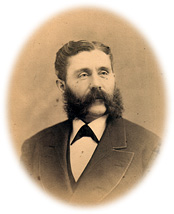
In 1990 I was partner in a graphic design venture, *The Windedale Design Company.* Displaying an early penchant for absurdity that would lead to such diversions as [VäporOS](/the-graveyard/), I created a faux history of the business with a fictitious founder, one Jacobus Q. Winedale. The following is a biography I drafted intended (but thankfully never used) for promotional purposes. It is presented here completely unedited, as embarrassing as that is.
*Note: I purchased the accompanying photograph in an antique store, having marveled at this anonymous gentleman’s stunning similarity to an [actual portrait](https://www.dalahus.com/coppermine/displayimage.php?album=17&pos=3) I painted of J.Q. Winedale.*
>

**THE REAL JACOBUS**
Jacobus Q. Winedale was born in the autumn of 1837 to poor mill workers in West Orange, New Jersey. There is little or no significance to his weaning years, except to say that despite a complete lack of schooling he managed to help his family’s income by painting “Going Out of Business” signs for local merchants (a feat no less great when realizing he could not read a word). Growing up destitute and school-less, Jacobus became a bitter, hateful young man, and tales proliferate of his quasi-legal dealings with the local tobacconist. At twenty-five, guided by a picture he saw of a gold prospector in California, he packed all his belongings into a carpet bag and began hitching his way west, dreaming of his fortune. Tragedy would record that day, however, for he could not read the caption under the picture, which read, *“…the last of the gold panners in the California Valley. All the gold is gone. Kaput. California is bust. Stay home.”*
>Jacobus Q. Winedale would never make it to California, however. Wandering westward, he eventually found work in 1862 as a farm hand in Kansas on the large, powerful estate of Ernst and Mary Lockjaw. Ernst, a noble, god-fearing Christian, despised Winedale and his vagabond ways. In spite of this, Winedale stayed on the farm for twelve years, driven to hard labor by Lockjaw. In 1874, Mary gave birth to a girl, christened Sarah J. Lockjaw. It then became Jacobus’s duty to care for the child, as Mary had become ill with Typhoid.
>As the years past, Jacobus grew to love the little girl, and in 1887, on the eve of her thirteenth year, a fifty year-old Jacobus Q. Winedale wed Sarah J. Lockjaw. Ernst Lockjaw was furious over this marriage, and disowned his daughter, banishing her and Winedale from the estate forever. Jacobus and a pregnant Sarah started the long journey back east.
>Returning to West Orange, Sarah gave birth to twin boys, Jonah and Jacobus Jr. Winedale had now returned to his work as a sign painter that he’d abandoned twenty-five years earlier, opening a shop bearing the name *Jacobus Q. Winedale, Sign Painter.*
>In 1912, Jonah and Jacobus Jr. took over the business from a seventy-five year old and senile Jacobus Q. Winedale and expanded the company, building a new office at Ashwood Terrace. The new shop bore the name, *J.Q. Winedale and Sons Sign and Design Company*.
>This incarnation of the company went broke in the depression after the last local merchant needed a “Going Out of Business” sign. It would be nearly one hundred years later, when two very distant cousins of the Winedale family would stumble upon records indicating that due to the strange tax laws of pre-depression New Jersey, the company was still officially alive. Seizing this opportunity, the cousins took control, renaming it *The Winedale Design Company.*
>Today The Winedale Design Company still resides at 21 Ashwood Terrace, providing high quality and affordable design work, in the spirit of the great Jacobus Q. Winedale.
*Continue on to page 2 for more items dredged from my vault of horrors.*
